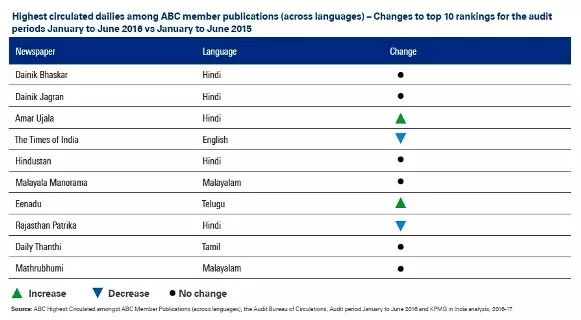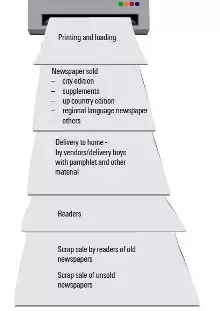What's driving circulation of Indian newspapers
Bucking the global trends, newspapers in India continues to grow. The Indian Media and Entertainment Industry Report, 2017, published by KPMG India, in association with FICCI, in March, explains the reasons.
19 Apr 2017 | By Dibyajyoti Sarma
Newspaper circulation in India continues to grow despite its global counterparts in America and Europe struggling for survival. The growth of the industry can be appraised by circulation and readership, with readership being the more apposite basis as generally in India a copy of the newspaper is shared by an entire family.
In 2016, the average cover prices for English newspaper saw a minimal increase in the range of 2 to 5%, for Hindi newspapers the increase was in the range of 10 to 12% and for other regional language newspapers was 14 to 18% depending on the market.
The growth in circulation is driven by the following factors.
Demographical changes

Over the past few decades, India has experienced many demographical changes. Literacy level across states has seen an upswing including literacy among women. This has primarily contributed to growth in readership as more people are being initiated into the world of reading and writing. The fastest growth in newspaper circulation was in states with strongest growth in literacy. India’s literacy rate stands at 74.0% with rural literacy rate at 68.9% and urban literacy rate at 84.9%.
Hyper-localisation
Trends in traditional newspaper readership in India show greater inclination towards regional language newspapers. In addition to growing literacy, there are other factors that have contributed to this growth. First, the Indian economy is a rural economy with more than 65% of India’s population residing in the rural areas. A paradigm shift is visible in the rural population over the past five decades as they become one of the most influential consumer groups with increased income levels and changing tastes and preferences.
Second, the coverage of local news by regional language newspapers has given circulation the much need momentum as it provided the people in the rural areas a medium to express their grievances and aspirations.
Third, localisation led to multi-edition newspapers with publishers syndicating national content with regional news and expanding their content diversity with supplements. The success of hyper-localisation is also attributed to readers’ predilection to read content in their first language.
Low pricing
The increase in cover price of an average Indian newspaper today has not kept pace with the multi-fold inflation in the past two decades. At under Rs 1,000 for an average annual subscription, newspapers in India are cheaper than in any other large newspaper market in the world. The difference between India and other countries is the population density and labour cost in newspaper distribution. In India, newspapers are delivered door-to-door and at very low cost. As many as 500 newspapers are delivered in an hour, while in the US given the suburban spread it would be just a fraction of that.
In India, newspapers are priced low or coupled with discounts or complimentary supplement/edition thereby making price a non-issue for the reader and building a loyal readership base which advertisers can target. This pricing model continues to pay rich dividends to the Indian newspaper industry.

Efficient distribution system
Another differentiator of Indian newspaper circulation is the effective and efficient distribution network. India’s newspaper distribution chain is unique and multi-tiered; newspapers are sold through an extensive network of agents and vendors.
Printing and loading: The distribution chain commences with printing, typically a newspaper is printed by 4 am. Printed newspapers are then counted, bundled and loaded into vehicles carrying the copies to various point of sale known as depots.
Delivery to door: Distribution from depots to the readers is entirely performed by the vendors. The vendor unbundles purchased copies, inserts any supplements, pamphlets and other promotional material and segregates them as per demand of the readers.
Value to vendors: Vendors form the lowest part of distribution chain and are paid commission as a percentage of the cover price by the newspaper companies. Newspaper companies regularly float promotional offers for vendors and in some rare cases also pay cash incentives. Vendors also have additional sources of income example pamphlets, which are manually inserted in the newspaper, are used by local advertisers as a mode of advertising; however, rates vary based on language of the newspaper, locality and consumer demographic. Similar to pamphlets, sometimes, stickers and small replica of a product are pasted on top of the newspaper for advertisement.
Distribution chain operates with limited resources, the entire distribution in managed manually with no use of technology and delivered on bicycles to readers at their door. The delivery charges are nominal. Also, entire circulation is usually completed within three hours and with two holidays in an entire year.
Despite the huge scale of operations, the error rate is very low. Thus with minimum costs, use of technology and investment, they achieve highest levels of customer satisfaction.











 See All
See All